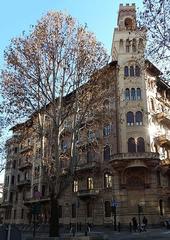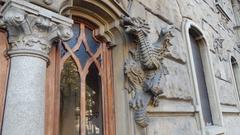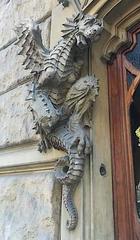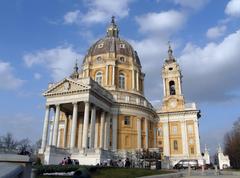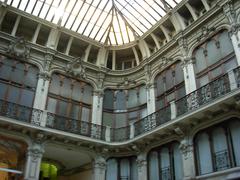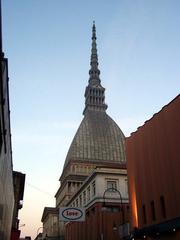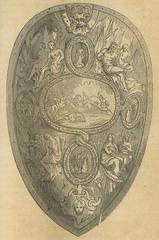
Comprehensive Guide to Visiting Palazzo della Vittoria, Chieri, Italy
Date: 01/08/2024
Introduction
Nestled in the picturesque town of Chieri, Italy, the Palazzo della Vittoria stands as a testament to the country’s rich historical and cultural heritage. Also known as Casa della Vittoria or Casa dei Draghi, this iconic monument was commissioned in 1918 by Giovanni Battista Carrera to commemorate Italy’s victory in World War I. Designed by engineer Gottardo Gussoni, its construction was completed in 1920, marking a significant recovery period for Italy’s post-war construction sector (Wikipedia). The building’s medieval-revival architecture, combined with French Gothic Revival elements, makes it a unique landmark in the Cit Turin district of Turin. Notably, the Palazzo is adorned with winged cement dragons, symbolic of Italy’s post-war power, earning it the nickname ‘House of Dragons’ (Atlas Obscura). This guide provides comprehensive insights into the history, architectural significance, and practical information for visiting Palazzo della Vittoria, ensuring a memorable experience for all visitors.
Table of Contents
- History of Palazzo della Vittoria
- Visiting Palazzo della Vittoria: Practical Information
- Historical Context of Cit Turin
- Architectural Significance
- Cultural Impact and Popular Culture
- Accessibility and Visitor Information
- Nearby Historical Sites
- Preservation and Conservation
- FAQ
History of Palazzo della Vittoria
Commission and Construction
The Palazzo della Vittoria, also known as Casa della Vittoria or Casa dei Draghi, was commissioned in 1918 by Giovanni Battista Carrera. The building was designed by engineer Gottardo Gussoni to commemorate Italy’s victory in World War I. The construction was completed in 1920, marking a significant moment of recovery for the post-war construction sector. This historical context is confirmed by a plaque placed on the facade of the building (Wikipedia).
Architectural Style and Features
The Palazzo della Vittoria is an exemplary piece of residential architecture in a Medieval-revival style, located in the Cit Turin district of Turin, Italy. The building rises six stories from the street and fronts the Corso Francia, a major boulevard running through the neighborhood. Its eclectic medievalist style is marked by the incursions of the French strain of Gothic Revival. This influence is evident in the structural details such as the portal and entrance hall, the balustrades of the balconies and internal staircases, and the pronounced angular oriel characterized by its mullioned windows and round three-light windows that culminate in a crenellated turret (Wikipedia).
Symbolism and Allegorical Elements
The building is also known as the ‘House of Dragons’ due to the winged, cement dragons located at the main entrance and on the windows. These dragons were designed to symbolize Italy’s post-war power. Other allegorical elements and details decorate the facade, adding to the building’s historical and cultural significance (Atlas Obscura).
Visiting Palazzo della Vittoria: Practical Information
Ticket Prices and Visiting Hours
While the Palazzo della Vittoria is primarily a residential building and does not operate as a museum with regular visiting hours or ticket sales, its exterior can be admired at any time. Tourists interested in exploring the interior features are advised to check for any special events or guided tours that might allow access.
Guided Tours and Special Events
Occasionally, guided tours are organized by local cultural associations. These tours provide insights into the building’s architectural and historical significance. For the latest information on tours and events, visitors should consult local tourist information centers or the official city website.
Best Times to Visit
The best time to visit the Palazzo della Vittoria is during the spring and autumn months when the weather is mild, and the area is less crowded. Early mornings or late afternoons provide the best lighting for photography.
Historical Context of Cit Turin
During the late nineteenth and early twentieth centuries, the residential area of Cit Turin was the epicenter of intense building activity predominantly characterized by the Liberty Style (Italian Art Nouveau). Parallel to the naturalism of this style was the development of the Gothic Revival, which infiltrated the district through its use in several important buildings, including the Palazzo della Vittoria.
Architectural Significance
The Casa della Vittoria is considered one of the most interesting examples of residential architecture in a Medieval-revival style in Turin. It is located in an area of great architectural interest that contains a high density of Art Nouveau and Gothic Revival buildings, including the nearby church of San Donato. The building’s beveled corner contains a niche at the angle of the Corso Francia with the street intersecting it. This niche seems to have been conceived to house a statue, which, however, has never been placed there (Wikipedia).
Cultural Impact and Popular Culture
The Casa della Vittoria has been featured in at least four films set in Turin, highlighting its cultural significance and iconic status in the city. The building’s unique architectural style and historical importance make it a popular subject for filmmakers and tourists alike (Wikipedia).
Accessibility and Visitor Information
The Casa della Vittoria can be easily reached from the M1 line (Fermi - Lingotto) of the Metropolitana at the station Principi d’Acaja. This accessibility makes it a convenient destination for tourists exploring the architectural and historical landmarks of Turin.
Nearby Historical Sites
The building is located not far from the famed houses known as the Casa Fenoglio-Lafleur and Villino Raby, both of which are significant examples of the Liberty Style in Turin. These nearby historical sites add to the architectural richness of the Cit Turin district and provide visitors with a comprehensive experience of the area’s historical and cultural heritage.
Preservation and Conservation
The Palazzo della Vittoria stands as a testament to the architectural and cultural heritage of Turin. Efforts to preserve and maintain the building are crucial to ensuring that future generations can appreciate its historical significance and architectural beauty. The building’s inclusion in various cultural and historical tours highlights its importance and the ongoing efforts to conserve its unique features (Atlas Obscura).
FAQ
What are the visiting hours for Palazzo della Vittoria?
The Palazzo della Vittoria is primarily a residential building and does not have regular visiting hours. However, its exterior can be viewed at any time.
Are there any tickets required to visit Palazzo della Vittoria?
There are no tickets required to view the exterior of Palazzo della Vittoria. For interior visits, check for special events or guided tours.
How can I reach Palazzo della Vittoria?
The Palazzo della Vittoria is accessible via the M1 line (Fermi - Lingotto) of the Metropolitana at the station Principi d’Acaja.
Are there guided tours available?
Occasionally, guided tours are organized by local cultural associations. Check with local tourist information centers for the latest information.
Conclusion
The Palazzo della Vittoria is a remarkable example of Medieval-revival architecture in Turin, Italy. Its historical significance, architectural beauty, and cultural impact make it a must-visit destination for tourists and history enthusiasts. The building’s unique features, including the winged dragons and Gothic Revival elements, symbolize Italy’s post-war power and recovery, adding to its allure and importance in the architectural landscape of Turin. For up-to-date information on visiting hours, tickets, and tours, be sure to consult local sources and plan your visit accordingly.
Exploring Palazzo della Vittoria: History, Visiting Hours, and Tickets in Chieri, Italy
Historical Significance
Palazzo della Vittoria, located in Chieri, Italy, is a testament to the rich historical tapestry of the region. Chieri itself dates back to pre-Roman times and has been a significant settlement through various historical epochs. The Palazzo della Vittoria stands as a symbol of the town’s medieval and Renaissance heritage. Chieri was once more prosperous than Turin, reflecting its importance in the region (Italia Slow Tour).
The Palazzo della Vittoria is a prime example of the architectural evolution that Chieri underwent, particularly during the Renaissance period. This era brought economic prosperity and a flourishing of the arts, with significant architectural endeavors such as the rebuilding of the Church of Santa Maria into its present form as the Duomo (Wikipedia).
Architectural Significance
The architectural significance of Palazzo della Vittoria lies in its blend of medieval and Renaissance styles. The building showcases the transition from the fortified structures of the Middle Ages to the more ornate and expansive designs of the Renaissance. This transition is evident in the Palazzo’s robust yet elegant design, featuring elements such as buttresses and tall stone portals sculpted with Romanesque motifs (Wikipedia).
The Palazzo della Vittoria also reflects the influence of the noble families who patronized its construction. The Balbi and Bertoni families, for instance, played a significant role in the architectural development of Chieri, including the Palazzo della Vittoria (Wikipedia).
Cultural Significance
Culturally, Palazzo della Vittoria is a focal point in Chieri’s rich heritage. The town has been a center for textile production since the 15th century, and the Palazzo is a reminder of the wealth and cultural vibrancy that this industry brought to the region. Chieri’s textile industry was renowned across Europe, particularly for its production of fustian, a type of heavy cloth (Italia Slow Tour).
The Palazzo also stands as a symbol of Chieri’s resilience and adaptability. Despite invasions and economic fluctuations, the town has maintained its cultural heritage, with the Palazzo della Vittoria being a prime example of this enduring legacy.
Visitor Experience
Visiting Palazzo della Vittoria offers a unique glimpse into Chieri’s historical and cultural landscape. The Palazzo is located in the heart of Chieri, making it easily accessible for tourists. Here are some tips for visitors to ensure a memorable experience:
Best Time to Visit
The best time to visit Palazzo della Vittoria is during the spring and autumn months when the weather is mild and the town is less crowded. This allows visitors to explore the Palazzo and its surroundings comfortably.
Guided Tours
To fully appreciate the historical and architectural significance of Palazzo della Vittoria, it is recommended to take a guided tour. Local guides provide in-depth knowledge about the Palazzo’s history, architectural features, and its role in Chieri’s cultural heritage.
Nearby Attractions
While visiting Palazzo della Vittoria, tourists can also explore other nearby attractions in Chieri. The Duomo of Chieri, also known as the Collegiate Church of Santa Maria della Scala, is a must-visit. This late-Gothic church is the principal church in Chieri and features stunning architectural and artistic elements (Wikipedia).
Another notable site is the Church of St. Bernardino and Rocco, known for its neoclassical facade and vibrant colors, which were restored to their original hues (Italia Slow Tour).
Local Cuisine
Visitors should not miss the opportunity to sample Chieri’s local cuisine. The town is famous for its rubatà breadsticks, Freisa wine, and the unique focaccia of Chieri. These culinary delights provide a taste of the region’s rich gastronomic heritage (Turismo Torino).
Practical Information
Opening Hours and Tickets
Before planning a visit, it is advisable to check the opening hours and ticket prices for Palazzo della Vittoria. These details can often be found on local tourism websites or by contacting the Chieri tourist office (Turismo Torino).
Accessibility
Palazzo della Vittoria is located in the historic center of Chieri, which features narrow streets and cobblestone paths. While this adds to the charm of the visit, it may pose challenges for visitors with mobility issues. It is recommended to check accessibility options in advance.
Accommodation
Chieri offers a range of accommodation options, from charming bed and breakfasts to more luxurious hotels. Staying in the town allows visitors to fully immerse themselves in the local culture and explore the Palazzo della Vittoria and other attractions at a leisurely pace.
Conclusion
Palazzo della Vittoria is not just a historical building; it is a symbol of Chieri’s rich cultural and architectural heritage. Its significance extends beyond its walls, reflecting the town’s historical prosperity, architectural evolution, and cultural vibrancy. A visit to Palazzo della Vittoria offers a unique opportunity to step back in time and experience the grandeur of Chieri’s past.
FAQ
What are the visiting hours for Palazzo della Vittoria? The visiting hours vary depending on the season. It is recommended to check the official Chieri tourism website or contact the local tourist office for the most up-to-date information.
How much do tickets cost for Palazzo della Vittoria? Ticket prices can vary. For current prices, please refer to the official tourism information or contact the Chieri tourist office.
Are there guided tours available at Palazzo della Vittoria? Yes, guided tours are available and highly recommended to fully appreciate the historical and architectural significance of the Palazzo.
What are some nearby attractions to Palazzo della Vittoria? Nearby attractions include the Duomo of Chieri and the Church of St. Bernardino and Rocco, both of which offer unique architectural and cultural experiences.
What local cuisine should I try when visiting Chieri? Visitors should try local specialties such as rubatà breadsticks, Freisa wine, and the unique focaccia of Chieri.
References
- Wikipedia contributors. (2023, July 5). Casa della Vittoria. In Wikipedia, The Free Encyclopedia. Retrieved from https://en.wikipedia.org/wiki/Casa_della_Vittoria
- Atlas Obscura contributors. (n.d.). Palazzo della Vittoria. Retrieved from https://www.atlasobscura.com/places/palazzo-della-vittoria
- Italia Slow Tour contributors. (n.d.). Chieri: the history of the city. Retrieved from https://www.italiaslowtour.com/chieri-history-city/
- Turismo Torino contributors. (n.d.). Hills and River Po: Chieri. Retrieved from https://www.turismotorino.org/en/territory/hills-river-po/chieri
